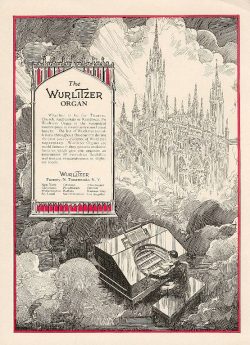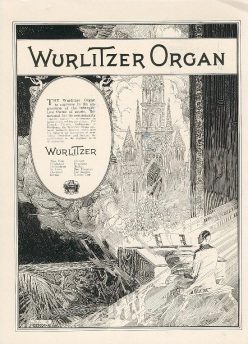The Riviera Theatre and Its Mighty Wurlitzer Pipe Organ
Click here to download an mp3 file of the Riviera
Wurlitzer
A history prepared by Bob Sieben
 |
Billed as the "Showplace of the Tonawandas", the Riviera Theatre was built during the year 1926, by the Yellen Family. The architects Leon H. Lempart and Son drew the plans, which were patterned after the Italian Renaissance. The interior artwork was painted at the Rochester Studio of Willard M. Lusk, by Ferdinand Kebely. The Wurlitzer Organ to be installed in the new Theatre, Opus 1524 was shipped from the Wurlitzer Factory on November 19, 1926. Listed as a Model 235 Special, the organ differed from a standard 3 manual 11 rank Model 235, by substituting an Oboe Horn rank of pipes from the standard Salicional pipes usually found on this model. Other differences included the omission of the standard remote Piano, and a 5 H.P. blower instead of the 7-1/2 H.P. The console was painted and decorated to harmonize with the Theatre’s interior, by Wurlitzer’s Band Organ Artist. |
Opening night, Thursday, December 30, 1926 of the New RIVERA (as it was spelled then) was a ‘gala event’ in the Tonawandas. Advance reservations for opening night cost $1.00. Present on this special evening, were the Mayors of both Tonawandas. From the stage, Mayor James P. Mackenzie of North Tonawanda, praised the President of the Ownership Corporation of the Theatre, Henry Henshel, and the Theatre’s Manager, James J. Kelly. Messages of Congratulation of the Grand Opening were received from Governor Alfred E. Smith, and famous movie producer Cecil B. Demille.
Featured on the screen, were the movies "Upstage" starring Norma Shearer, "The Mona Lisa", in Technicolor, a short comedy, and the newsreel. Organist Fred Meyer accompanied the films and soloed at the Mighty Wurlitzer. The stage featured vaudeville and musical events, as well.
| During the depression years, the theatre became a Shea’s Theatre, and
the name was changed from "New Rivera" to "Shea’s Riviera". The
organ was extensively used for the first seven years, and featured organists Al
Bollington, "Dusty" Rhodes, Jack Ward and Art Melgier. In the early 1930’s use of the organ was discontinued as a regular program feature, and heard thereafter only on special occasions. Time and lack of maintenance took its toll on the instrument. When Mr. Carlton Finch and his father Harry obtained an OK from the theatre’s management to restore the organ in 1944, only part of the great manual would play. |
|
There followed months of hard labor, cleaning magnets, removing fallen plaster from organ pipes, replacing missing and damaged pipes, and cleaning of electrical contacts. On "D" day 1944 the organ was in good enough shape for organist Carlton to celebrate the event by giving the first public concert at the Riviera in at least 10 years.
Although the Finchs continued restoration and maintenance on the organ, the public did not hear the organ again until the Riviera’s management introduced "teenage dance parties’ on the Theatre’s stage with dance music supplied by Carlton at the Mighty Wurlitzer. The dance parties did not last for long, and upon their departure in the early 1950’s, the organ again became silent, except for weekly "off hour" practice sessions by Carlton.
It was not heard again until March 18, 1962, when the Niagara Frontier Theatre Organ Enthusiasts sponsored a concert featuring Carlton on the Mighty Wurlitzer. The theatre organ club thereafter held one or two annual concerts at the Riviera, usually on Sunday morning right up to regular matinee show time. The theatre admission was charged at the box office for these concerts, which also entitled the members to stay and see the regular show.
On July 3, 1964, the Riviera Wurlitzer was spotlighted in a special concert, with artist Jack Ward at the console. The concert started at midnight and was one of a series that was held on the Niagara Frontier in 1964.
The theatre organ club continued to sponsor one or two "Sunday Morning" concerts per year for the next few years.
During this time the Riviera became part of the Dipson Theatre chain, and with this change, brought a manager whom himself was an organ enthusiast. Carlton and Harry Finch, who kept the organ alive and active since 1944, requested the club’s help to do a more extensive restoration. William Hatzenbuhler, acknowledged organ builder and technician in this area, along with club volunteers adopted the restoration project. Manager, Frank Guzzetta, assured fullest cooperation.
June 26, 1967 saw a drastic departure from the usual "Sunday Morning" club organ concerts at the "Riv". For this concert, the theatre was rented on a weekday evening, a name artist from out-of-town was hired to play, and the Riviera’s doors were opened to the public for the event. The club was barely able to meet expenses-plus, but this concert set the pattern for the many successful monthly concerts, as we know them today. By 1969 these public concerts were heard at the Riviera 12 to 14 times yearly, with frequent use of the organ for special events as well.
During this time the organ itself saw improvements, as well as expansion. The dormant elevator was repaired and once again the console rose in splendor from its pit. Various instruments, and pipes within the organ began to sound forth. A sheet of board found blocking the sound from the pipe loft was removed; why it was place there, and by whom, remained a mystery.
Approximately June 15, 1970 the Riviera changed from a Dipson Theatre, and was sold to MDA Associates. The theatre operated under MDA until April 5, 1971 when the theatre closed suddenly. The future of the Riviera was overcast; it went up for auction on August 12, 1971, when it was reacquired by Smith Properties (owned by Max Yellen). The Riviera remained closed for a year, until it was acquired by MACDOP Enterprises and reopened April 27, 1972 with North Tonawanda’s mayor present for the opening.
 |
During the one-year closure of the Theatre, however, the monthly organ concerts continued as usual,
the theatre being opened for one night a month. Work on the organ also continued. The
Wurlitzer organ from the Kensington Theatre in Buffalo was donated to the Riviera Theatre
project in 1970, and although that organ had been badly damaged by flood and vandalism,
many of the parts of this organ were eventually incorporated into the "Riv"
organ. The club purchased a brand new set of Post Horn pipes for the organ, which were
playing by the autumn of 1971. New modern electrical relays and switches were purchased by
the club to compliment the old existing equipment. This would allow planned expansion of
the organ’s original 11 ranks of pipes. To help finance the Riviera’s secure future, the club made an offer to purchase the Wurlitzer for a substantial amount, along with a provision to have the instrument remain in the theatre. This offer was eventually accepted, the N.F.A.T.O.S. now owned the organ and at least could assure its future. |
The club enhanced the theatre itself with the purchase of a huge crystal chandelier that formerly graced the Genesee Theatre in Buffalo. Installed in the Riviera’s main dome in January 1974, the chandelier measured 10 feet in diameter, 14 feet high, contained 15,000 French crystals and had 3 circuits of 35 bulbs each. A smaller chandelier that came from the Park Lane Restaurant of Buffalo was installed in the Riviera’s outer lobby at the same time. Also, added to the stage equipment was a scenic backdrop donated from the Bradford (PA) Theatre. A very historic grand piano was also acquired from the same theatre at the same time. This piano was to be used for stage presentations. It should be noted that this instrument is separate from the other piano already connected to the organ.
Meanwhile, the enlargement and restoration of the Wurlitzer by club members continued. As mentioned, a player piano was acquired and converted to play remotely, from the organ’s console. Additional organ parts and pipes were donated to the Riviera project from Buffalo’s Century Theatre and installed by the work crew. The console itself received a facelift all of the artwork and paint was professionally done by an artist. The stop tablets were rearranged, and many new one were added. Most of this work was done in 1974. By 1975 the organ had grown to 16 ranks of pipes.
The theatre ran a full-length silent 1920’s movie, "Wings" for a 10-day period with organ accompaniment by Art Melgier in February of 1973. Two commercial recordings were made on the "Riv’s" Wurlitzer by artist Frank Olsen by 1975. On December 15, 1976 the 50th anniversary of the Theatre’s first opening was celebrated in concert by artist Frank Olsen.
| The Riviera Theatre was placed on the Register of Historic Landmarks by the U.S. Department of the Interior – April 22, 1980 – but the future of the building was somewhat in doubt. A "Save the Riviera" benefit concert was held in June of 1981. |  |
The theatre was then acquired in early 1982 by SALED Properties, with the provision that the Wurlitzer Organ be a part of the sale of the building. The organ club responded, in the interest of keeping the theatre alive, and sold the organ back to the new owners. The Riviera also became the headquarters for a chain known as Key Theatres under this new ownership. In August of 1986, two of the Key Theatre in this area introduced live comedy on stage, on Saturday nights before the regular movie. The Riviera had the added feature of providing an organ interlude, featuring theatre organist Eddie Baker, prior to the stage comedy presentations. This special is quite popular among the patron right up to the present time. (Note: this was written in 1989, the theatre does not present comedy on Saturday evenings any longer).
The Mighty Wurlitzer has grown to 20 ranks of pipes in the meantime, and work on the instrument continues constantly. Unseen refinements are being accomplished, in off-hours, by the diligent work crew. The work on a pipe organ continues constantly, with no end in sight these instrument need constant attention and tuning. The only reward for those that constantly toil with these "beasts" is "that monthly concert, when the organ sings back its praises".
Early in 1988, the Riviera was once again put up for sale, along with its Mighty Wurlitzer. The organ club (Niagara Frontier Theatre Organ Society) decided an attempt should be made to purchase the theatre, by the club itself, and on August 12, 1988 a ‘gentleman’s agreement’ was reached with the owners. In the next few months a fund raising drive was undertaken in the Tonawandas and Western New York. Even the City of North Tonawanda itself attracted widespread interest and help. On February 14, 1989 the Niagara Frontier Theatre Organ Society (N.F.T.O.S.) closed the deal to purchase the Riviera and its Wurlitzer. Every effort of the club, city and Western New York is geared towards the goal of preserving the Riviera and its heritage, and to turn this fine theatre into a "Performing Arts Center of the Tonawanda".
The Riviera’s Mighty Wurlitzer has provided more entertainment consistently in its original setting than most other theatre organs, nationwide. Many top name artists, in this country, have performed here in hundreds of concerts over the past 22 years. The Riviera’s organ has even been acclaimed internationally by artist appearances from Europe, Australia, Britain and South America. Several popular organists played their ‘first’ public concert at the Riviera Theatre. The organ has been televised on several occasions, and several commercial recordings have been made on it. Indeed the Riviera organ is well known here and abroad.
|
The 63-year history of the Riviera Theatre has indeed been very
interesting and frightful on a couple of occasions. Fortunately, the wrecking ball was
evaded, as was the fate of over 30 other theatres in Western New York. The Riviera and the
Shea’s Buffalo are the only standing examples of the movie palaces and their original
"Mighty Pipe Organs" in an area which once boasted over 40 theatres with organs.
Let us all share the dream of the Niagara Frontier Theatre Organ Society Club (Now called the Riviera Theatre and Organ Preservation
Society) – that many more successful chapters of the Riviera’s history will
be written in years to come, and that this heritage may be shared for many future
generations. In 1999 RTOPS replaced the old Wurlitzer pneumatic relay with an Artisan solid-state relay.The theatre has been the product of extensive restoration and renovation since 1991. This work has been carried out by many dedicated volunteers who donate many hours of their time. If you ever have the opportunity to visit this fine neighborhood movie palace of yesteryear take a moment to thank those who have saved her from the wrecking ball. |
If you have any additional information about the Riviera Theatre you feel should be included in this history please send e-mail to webmaster@nivek.com.
Riviera Home
| Upcoming Events | Wurlitzer History
Wurlitzer Stop List | Wurlitzer Concert Schedule
Wurlitzer Home